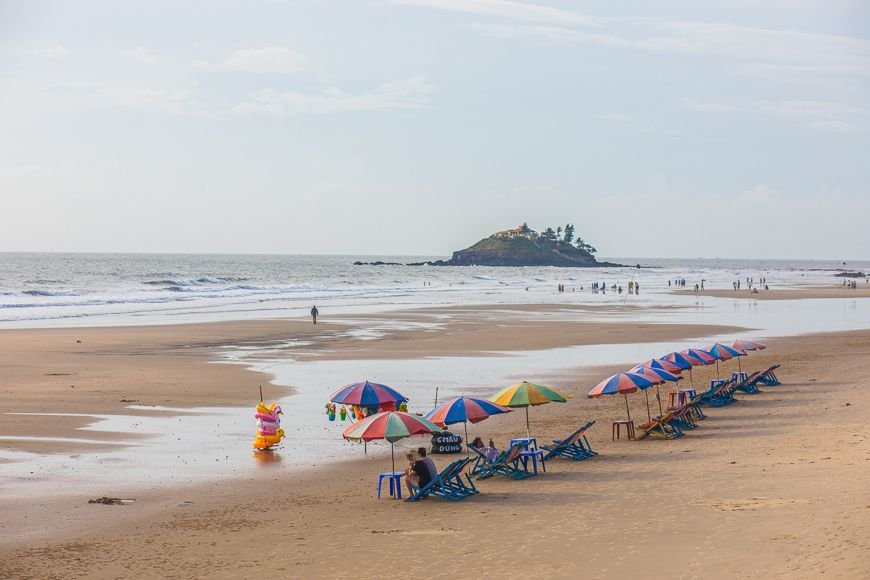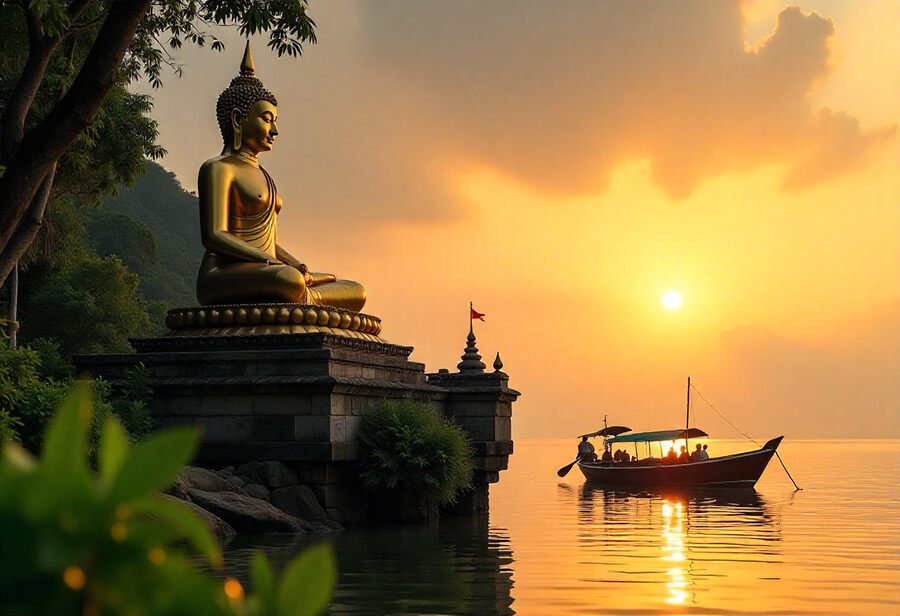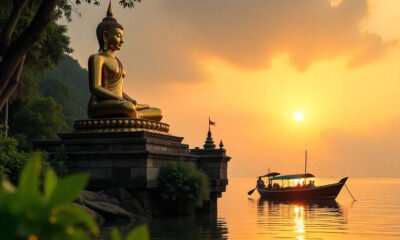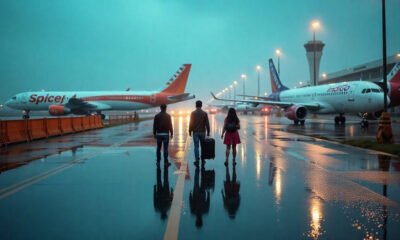Asia Travel Pulse
Vietnam’s Vung Tau Enhances Visitor Comfort with New Public Sanitation Stations Along Bai Sau Beach

Published on
August 9, 2025 |
Vung Tau, the lively coastal hub of Vietnam, is making bold moves to enhance its beach tourism framework. A standout initiative currently in the works is the rollout of a series of public sanitation blocks stretching along the sandy stretch of Bai Sau Beach. These facilities are being carefully crafted to boost visitor comfort without compromising the coastal landscape’s natural beauty. Since the city attracts more than a million beach lovers every year, the project is poised to raise the bar on convenience and hygiene alike, making every day by the water a cleaner and more pleasant one.
The Need for Sanitation Upgrades
As one of Vietnam’s prime beach destinations, Vung Tau has long been recognised for its natural beauty and rich cultural heritage. However, as the tourism industry in the region continues to grow, so does the demand for more efficient and accessible public amenities. While the city has seen a steady rise in the number of visitors, the lack of adequate public sanitation facilities has often been a challenge. Recognising this, local authorities have embarked on a project aimed at upgrading the coastal infrastructure to accommodate the rising numbers of tourists in a more sustainable and hygienic manner.
The Bai Sau Beach area, which stretches across several kilometres of golden sand, has been selected as the focal point for this upgrade. The beach is a popular destination for both local and international visitors, offering not just breathtaking views but also a host of activities like swimming, sunbathing, and beach sports. However, the scarcity of public restrooms and showers along the beach has led to issues with cleanliness and convenience. To address this, the city is implementing a range of public sanitation stations that will cater to tourists and locals alike.
Unique Architectural Designs of the Sanitation Facilities
The newly constructed sanitation stations along Bai Sau Beach are not just functional; they also incorporate creative architectural themes. Each station is designed with unique motifs that reflect the natural surroundings and cultural aspects of the region. Some of the most notable designs include structures inspired by seashells, boats, and even the oil and gas industry—an important sector in the local economy.
Among the key facilities is the “Gas Station”, located near the end of Thuy Van Street, adjacent to Nguyen An Ninh Street. Spanning an impressive 1,000 square meters, this facility is an architectural marvel that combines functionality with design. It features a four-metre-deep underground section that houses the sanitation amenities, ensuring they remain unobtrusive while still providing ample facilities for visitors. The entrance area of this station has also been transformed into a scenic spot, offering visitors a place to rest while enjoying the panoramic views of the beach.
Other stations being built include the “Fishing Village”, which is inspired by a sailboat, and the “Seashell” and “Cloud” stations, each embodying elements of the ocean and sky. These unique structures not only enhance the aesthetic appeal of the beach but also serve as a testament to the city’s commitment to improving tourism facilities while respecting the natural environment.
Investment and Impact on Tourism
This upgrade of public sanitation facilities is part of a much larger project aimed at revamping the entire Bai Sau Beach area. The initiative is expected to have a significant impact on the local tourism industry by providing better services to visitors, thereby attracting even more tourists to the region. The total investment in this project is estimated to be nearly VND 1.1 trillion (approximately US$43 million), a substantial sum that highlights the commitment of the local authorities to improving the city’s tourism infrastructure.
Construction of these facilities began in October of the previous year and is expected to be completed soon. The project has garnered positive reactions from both local residents and tourists, who are eager to see the improvements. By providing modern, clean, and accessible public sanitation options, the city is ensuring that visitors can enjoy the beauty of Bai Sau Beach without the inconvenience of inadequate amenities.
Expected Benefits for Local Economy
The renovation of Bai Sau Beach and the addition of new sanitation facilities will undoubtedly have far-reaching effects on the local economy. By improving the visitor experience, the project is expected to increase the length of stay for tourists, encouraging them to explore more of Vung Tau’s attractions. This, in turn, will boost local businesses, particularly those in the hospitality and service industries, which have been struggling to meet the demands of the increasing number of tourists.
In addition, the development of these facilities will likely have a positive environmental impact by promoting cleaner, more sustainable tourism practices. The careful integration of these amenities into the landscape ensures that the natural beauty of the beach is not compromised, and visitors will be able to enjoy the area in a more comfortable and hygienic setting.
A Long-Term Vision for Vung Tau’s Tourism Future
The development of public sanitation facilities at Bai Sau Beach represents just one facet of Vung Tau’s broader strategy to revamp its tourism infrastructure. With plans for further improvements in transportation, public spaces, and hospitality services, the city aims to position itself as one of Vietnam’s top tourist destinations in the coming years.
As the tourism sector continues to grow, the focus will be on creating a balance between environmental conservation and infrastructure development. Vung Tau is keen on preserving its natural resources while enhancing the visitor experience, ensuring that tourism remains a sustainable driver of economic growth for the region.
A Step Toward a Cleaner, More Accessible Vung Tau
The rollout of public sanitation facilities along Bai Sau Beach represents a significant step forward in Vung Tau’s continued push to elevate its tourism experience. With infrastructure upgrades on the rise, visitors can expect a hygienic, convenient, and pleasurable stay. Each amenity is crafted to harmonise with the surrounding scenery, reinforcing the city’s charm without disrupting its coastal allure. Consequently, Vung Tau gradually firms its appeal to the diverse travellers of tomorrow, reinforcing its position on both the domestic and international maps.
Image Credit: Vietnam Tourism Official Website
Asia Travel Pulse
Thailand, Japan, Indonesia, Malaysia, And More Demonstrate Strong Growth In Repeat Travel As Agoda Reveals The Favourite Cities That Keep Visitors Coming Back

Published on
August 9, 2025 |
Thailand, Japan, Indonesia, Malaysia, and several other countries are experiencing remarkable growth in repeat travel, driven by travelers’ deepening appreciation for their unique cultures, vibrant cities, and diverse experiences. According to Agoda’s latest data, these destinations are home to favorite cities that consistently attract visitors back, highlighting their ability to offer unforgettable stays, rich local attractions, and exceptional hospitality that inspire repeat visits and foster strong traveler loyalty.
Agoda, the prominent digital travel platform, has revealed its latest Repeat Visitor Ranking, shining a spotlight on Asian cities that travellers can’t seem to resist coming back to. This ranking draws on booking data collected during the first half of the year, identifying the top destinations with the highest numbers of repeat visitors. For the second year running, Bangkok retains the number one position, followed closely by Tokyo, Seoul, Bali, and Osaka. Each of these cities offers unique attractions and experiences that encourage travellers to return again and again.
Top 10 Most Revisited Destinations
- Bangkok, Thailand
- Tokyo, Japan
- Seoul, South Korea
- Bali, Indonesia
- Osaka, Japan
- Taipei, Taiwan
- Kuala Lumpur, Malaysia
- Da Nang, Vietnam
- Johor Bahru, Malaysia
- Hong Kong
Source: Agoda Repeat Visitor Ranking
Repeat visits act as a clear indicator of success for tourism boards and destination marketers. When travellers return to the same place multiple times, it reflects well on the destination’s appeal and the effectiveness of promotional campaigns. Many visitors do not just revisit their favourite cities; they also use those return trips to explore less familiar areas within the same country or region.
Agoda’s data shows that a considerable portion of travellers book trips to the same city or country multiple times, underscoring the emotional and experiential bonds that draw people back. The cities topping this list consistently offer vibrant cultures, excellent food, and a wealth of attractions, making them irresistible for those seeking both familiar comforts and new discoveries.
Bangkok Remains Unrivalled
Bangkok has reclaimed the number one position, solidifying its reputation as one of Asia’s most irresistible travel hotspots. Tourists regularly highlight the city’s vibrant street scenes, diverse and delicious food offerings, and abundant cultural treasures. To keep this momentum going, the Tourism Authority of Thailand has stepped up its initiatives by rolling out targeted promotions and collaborating closely with industry stakeholders to elevate the overall visitor experience.
Other regions in Thailand are also drawing in returning visitors. Phuket, Pattaya, Chiang Mai, and Hat Yai have all seen substantial repeat visitor numbers, highlighting the country’s broad appeal beyond just its capital. To support this growth, Thailand has invested in upgrading its transportation infrastructure. These improvements include expanding domestic airports, enhancing intercity rail networks, and developing urban mass transit systems to make travel more convenient and comfortable for visitors.
Why Do Travellers Keep Coming Back?
Agoda’s surveys help explain why people repeatedly visit these top destinations. The key factors include:
- Ease of Travel: Destinations that offer straightforward access, good connectivity, and efficient transport systems make returning trips hassle-free.
Culinary Experiences: The variety and richness of local food greatly influence travellers’ choices. Destinations known for their flavorful and diverse cuisine encourage visitors to come back repeatedly to explore new tastes and enjoy familiar favourites. - Convenient Location: Proximity to other destinations or natural attractions often encourages repeat visits as travellers use one city as a base to explore nearby areas.
- Safety and Cleanliness: Visitors feel more comfortable revisiting places where they perceive high standards of safety and cleanliness.
- Positive Previous Experiences: Most importantly, travellers return to places where they have already had enjoyable and memorable experiences.
These motivations create strong emotional connections between travellers and destinations, making repeat visits a natural choice.
Traveller Demographics and Trip Purposes
Agoda’s data also reveals interesting patterns related to traveller demographics and the reasons behind their repeat visits. For example, many travellers from countries such as the Philippines, Vietnam, and India show a strong inclination to revisit their favourite cities. Their reasons vary widely, from seeking adventure and exploring local food scenes to reconnecting with family and friends.
This diversity in purpose highlights that repeat visitors are not a monolithic group. Some return for leisure and relaxation, others for cultural immersion or business, and many combine several motivations. Repeat travel often strengthens these bonds, encouraging travellers to explore new parts of a destination they had not previously experienced.
Loyalty Programs and Traveller Benefits
Alongside these travel trends, Agoda supports frequent travellers with its loyalty programmes. The Agoda VIP programme offers tiered membership levels — Member, VIP Silver, VIP Gold, and VIP Platinum — which travellers can unlock based on the number of bookings they make. As travellers move up the tiers, they gain access to exclusive discounts, special offers, and personalized services.
Additionally, Agoda provides a PointsMAX feature, allowing users to earn airline miles or other loyalty points from partner programmes when they book accommodation through the platform. This integration adds extra value for repeat visitors and encourages loyalty to Agoda’s services, complementing the overall traveller experience.
What This Means for Asian Tourism
The Repeat Visitor Ranking reflects a vibrant and growing interest in Asia’s travel destinations. Cities like Bangkok, Tokyo, Seoul, and Bali continue to draw visitors with a mix of tradition, modernity, and accessible experiences. For tourism authorities, high repeat visitation rates confirm that their promotional strategies resonate well with travellers, and their investments in infrastructure and services pay off.
Furthermore, these cities act as gateways to their respective regions, inspiring visitors to explore surrounding areas on subsequent trips. With tourism expected to grow steadily in the coming years, destinations that nurture repeat visitors stand to benefit from sustained economic impact and cultural exchange.
Thailand, Japan, Indonesia, Malaysia, and more are seeing strong repeat travel growth as Agoda reveals that their favorite cities offer unique cultural experiences, excellent hospitality, and vibrant attractions that keep visitors coming back time and again.
Agoda’s Repeat Visitor Ranking offers valuable insights into which Asian cities travellers love enough to revisit repeatedly. The data highlights not only popular destinations but also the qualities that inspire loyalty — from culinary delights and ease of travel to safety and memorable experiences. As tourism boards continue to refine their strategies, repeat visitation will remain a key metric of success, helping cities maintain their place on the traveller’s map for years to come.
Asia Travel Pulse
AirAsia ‘Discover ASEAN’ Microsite: A New Era of Travel for Southeast Asia Tourism

Published on
August 9, 2025 |
AirAsia just launched the ‘Discover ASEAN’ microsite to give Southeast Asia’s tourism sector a big boost. This online hub is perfect for both international visitors and locals who want a simple way to find and book everything Trip-related. The microsite highlights the region’s rich cultural, historical, and natural attractions, letting travelers quickly plan their perfect getaway with AirAsia.
The initiative fits seamlessly into Southeast Asia’s plan to bounce back from the pandemic and stay on the global map. The microsite isn’t just for booking flights; it’s a one-stop shop for experiences, special offers, and must-see spots across every ASEAN country. By gathering all this info in one place, AirAsia hopes to create a stronger bond between visitors and the one-of-a-kind treasures of Southeast Asia.
The Concept of the ‘Discover ASEAN’ Microsite
AirAsia’s ‘Discover ASEAN’ microsite offers a fresh and engaging way for travelers to explore the diverse beauty of Southeast Asia. With detailed destination guides, exclusive promotions, and a plethora of travel tips, the site is a treasure trove of information for those interested in traveling within the ASEAN region.
Facilitating Seamless Travel Planning with AirAsia
A key feature of the ‘Discover ASEAN’ microsite is its seamless integration with AirAsia’s extensive flight network. Travelers can easily book flights directly from the platform, ensuring a streamlined process from trip planning to departure.
Additionally, the microsite features local experiences, excursions, and activities that travelers can add to their itineraries.
This feature allows tourists to not only book flights but also enhance their journeys with locally inspired activities, reinforcing the region’s appeal to both seasoned travelers and newcomers looking for authentic experiences.
Promoting Regional Connectivity and Tourism Recovery
The ‘Discover ASEAN’ microsite is launching at a critical time for Southeast Asia’s tourism sector. With borders reopening and international tourism gradually picking up, AirAsia’s initiative comes as a timely solution to help rebuild regional travel and support local economies.
The site’s focus on regional connectivity and promoting travel within ASEAN countries is particularly relevant in this context. By encouraging residents of Southeast Asian nations to explore their neighbors, AirAsia aims to foster a sense of regional pride while simultaneously boosting local tourism economies. This initiative contributes to the broader goal of promoting intra-regional tourism, which will be a critical component of Southeast Asia’s post-pandemic recovery.
Sustainable Tourism Practices and Local Engagement
Sustainability is a central theme in the ‘Discover ASEAN’ microsite’s design. AirAsia is committed to promoting responsible tourism within the ASEAN region by supporting eco-friendly practices and showcasing destinations that prioritize sustainability. Through the platform, travelers are encouraged to make environmentally conscious decisions, such as opting for eco-tourism experiences, using local transportation options, and staying at sustainable accommodations.
In addition to promoting environmental sustainability, the microsite highlights ways in which travelers can contribute to local communities. Whether through cultural exchange programs, local artisan products, or supporting small businesses, the platform aims to connect travelers with authentic experiences that help foster economic growth in the region’s less-visited areas.
By integrating sustainable travel options and ethical tourism practices, the ‘Discover ASEAN’ microsite hopes to create a more responsible travel ecosystem, ensuring that future generations can continue to enjoy the beauty and diversity of Southeast Asia.
New Opportunities for ASEAN Tourism
The ‘Discover ASEAN’ microsite represents a bold move by AirAsia to not only attract tourists to the ASEAN region but to also increase regional collaboration among ASEAN member countries. Tourism is a key economic driver for Southeast Asia, and by leveraging AirAsia’s extensive network, the microsite serves as a tool for tourism boards, local businesses, and the hospitality sector to gain greater visibility in international markets.
By promoting secondary cities and emerging destinations, the ‘Discover ASEAN’ initiative helps decongest popular tourist spots, encouraging visitors to explore new places. This effort aligns with the broader goal of sustainable tourism, where the benefits of tourism are more evenly distributed across the region, and local communities are given more opportunities to engage with the global travel market.
What This Means for Southeast Asia Tourism Landscape
Looking forward, the ‘Discover ASEAN’ microsite could significantly reshape Southeast Asia’s tourism landscape. The platform provides an easy-to-use, one-stop solution for travelers, offering all the information and booking tools needed to make travel decisions. It also acts as a powerful marketing tool for ASEAN countries, giving them the ability to showcase their unique attractions to a global audience.
For travelers, the ‘Discover ASEAN’ microsite enhances their understanding of the region’s diversity and helps them find destinations that fit their travel interests, whether they’re looking for cultural experiences, adventure, or relaxation. With this initiative, AirAsia not only promotes tourism in Southeast Asia but also positions itself as a leader in regional travel, making it easier for everyone to discover the wonders of the ASEAN region.
The Future of Southeast Asia Tourism
The ‘Discover ASEAN’ microsite isn’t just another travel website; it’s a smart move to boost tourism across Southeast Asia. With easy-to-navigate travel guides, eco-friendly travel choices, and quick booking tools, AirAsia is paving a smooth and modern path for travelers. As the region heals from the pandemic, tools like the microsite will play a key role in attracting both local and global visitors, keeping Southeast Asia in the spotlight as a must-visit travel hotspot.
For visitors, the road ahead for Southeast Asia tourism sparkles with opportunities. New routes, fresh activities, and deep cultural stories are ready to be embraced. The ‘Discover ASEAN’ microsite is only the opening chapter of a thrilling story about the people and places that make Southeast Asia so special.
Asia Travel Pulse
Hanoi Emerges as a Premier Golf Tourism Destination in Vietnam

Published on
August 9, 2025 |
Hanoi, Vietnam’s lively capital, has quickly become a must-visit spot for golf tourists, now generating 8 to 10 per cent of the country’s total tourism income. Excellent golf courses and a fast-growing travel market are drawing visitors from around the globe. The city’s recent wins as the “World’s Best Golf City Destination” for 2023 and 2024, awarded by the World Golf Awards, officially rank it as one of the leading golf cities in the world.
The Rise of Golf Tourism in Hanoi
Hanoi’s golf tourism sector has experienced exponential growth over the past few years. As a result, the city has gained international recognition for its expansive golf facilities and high-end tourism offerings. The capital is home to numerous golf courses that meet the exacting standards of affluent visitors, particularly from international markets, making it a key player in Vietnam’s luxury tourism industry.
Prominent golf courses in Hanoi, such as Kings Island Golf (also known as Dong Mo Golf Course), are designed to cater to this elite demographic. Covering 350 hectares of land and 1,500 hectares of water surface, Kings Island Golf is Hanoi’s first and largest golf course, featuring 55 holes spread across three sub-courses. The facility is a major draw, attracting around 15,000 international visitors each year. It offers a comprehensive range of services beyond the green, including accommodations, wellness centres, and banquet services, making it a one-stop destination for golf lovers and leisure travellers alike.
In addition to Kings Island Golf, Sky Lake Resort & Golf Club in Tran Phu commune stands out with its 36-hole course. Sky Lake provides not just golfing facilities but also conference rooms and golf retail outlets, making it an ideal venue for both leisure and business travellers. These golf clubs are not only sports hubs but are also known for hosting major tournaments, which in turn contribute significantly to Hanoi’s tourism industry by attracting international and domestic tourists alike.
Scenic Golf Venues and Luxurious Accommodations
Hanoi’s diverse and scenic golf offerings include renowned venues such as Van Tri Golf Club, BRG Legend Hill Golf Resort, Hanoi Golf Club, and Long Bien Golf Course. Each of these locations boasts stunning landscapes that add to the overall experience, and they all meet international standards in terms of service and course quality.
The growth of golf tourism in Hanoi has been complemented by a parallel boom in the city’s accommodation sector. With a broad array of five-star hotels and serviced apartments, the city is well-equipped to cater to the needs of high-end travellers. The presence of international hotel chains such as JW Marriott, Sheraton, and Metropole ensures that visitors enjoy world-class services alongside their golfing experience. These luxurious accommodations are integral to Hanoi’s overall appeal, positioning the city as a hub for both golf and MICE (Meetings, Incentives, Conferences, and Exhibitions) tourism.
This synergy between elite golf courses and luxury accommodations allows Hanoi to cater to a wide range of affluent tourists. Golf enthusiasts can experience top-tier golfing facilities during the day and unwind at upscale hotels in the evening. In turn, the city’s dynamic MICE tourism market, supported by its world-class venues and hotels, continues to attract business travellers seeking both leisure and corporate activities.
Challenges and Opportunities for Growth
Despite its success, Hanoi’s golf tourism faces several challenges that hinder its full potential. While the city has seen impressive growth in its golf tourism sector, it has yet to reach the scale of regional competitors such as Thailand, Malaysia, and Singapore, which regularly host large-scale international tournaments. Hanoi’s golf courses have also primarily catered to individual tourists, with fewer group tours—a trend that limits the economic benefits of these premium facilities.
The city’s golf infrastructure, though robust, is underutilised due to a lack of coordinated efforts among various stakeholders in the tourism and golf industries. To address this gap, there is a pressing need for greater collaboration between golf courses, travel agencies, and other businesses within the tourism sector. This would enable the development of a broader range of customised and appealing golf tourism packages that can attract diverse international markets.
Strategies for Enhancing Golf Tourism
Key industry figures have emphasised the importance of diversifying the offerings within Hanoi’s golf tourism sector. Combining golf with cultural tourism and MICE experiences is seen as an effective strategy to broaden the appeal of the city. By offering a mix of leisure and cultural activities alongside high-quality golfing experiences, Hanoi can position itself as a premier destination for both golfers and travellers seeking a more immersive travel experience.
Integrating more entertainment options, such as live performances and interactive cultural experiences, could also enhance the appeal of Hanoi’s golf tourism. The development of customised golf tourism products tailored to the preferences of different markets could make Hanoi more attractive to a broader range of visitors.
Furthermore, streamlining the booking process for golf tour groups could improve the city’s competitiveness in attracting high-end groups. As it stands, many golf courses prioritise individual bookings, which complicates arrangements for group tours. Greater collaboration across the golf tourism value chain would help reduce costs and improve the overall experience for group travellers.
The Road Ahead for Hanoi’s Golf Tourism
The Hanoi Department of Tourism recognises golf tourism as a key focus for the city’s future development. Efforts are ongoing to enhance the city’s offerings in golf tourism while also expanding experiential travel products that can encourage longer stays. By further strengthening its golf tourism infrastructure and diversifying its tourism products, Hanoi is poised to continue attracting international visitors looking for a unique blend of luxury, sport, and culture.
With its exceptional golf courses, luxury accommodations, and thriving MICE sector, Hanoi is well on its way to becoming one of the leading golf tourism destinations in the region. The city’s growing prominence in the global golf tourism market is a testament to its commitment to high-quality offerings and its capacity to provide world-class experiences to travellers from all corners of the globe.
Conclusion
Hanoi’s golf tourism sector keeps gaining momentum, firmly establishing the city as a magnet for golfers and luxury travellers alike. Although it grapples with logistics and service-layer gaps, the city is steadily refining its appeal and is on track to secure a major role in the Southeast Asian golf tourism scene. Ongoing upgrades to transport, alongside a broader push to diversify the tourism portfolio, suggest that Hanoi is on a sustainable trajectory to shine as a leading golf stop in the region.
Image Credit: Vietnam Tourism Official Website
-

 Brand Stories3 weeks ago
Brand Stories3 weeks agoBloom Hotels: A Modern Vision of Hospitality Redefining Travel
-

 Brand Stories2 weeks ago
Brand Stories2 weeks agoCheQin.ai sets a new standard for hotel booking with its AI capabilities: empowering travellers to bargain, choose the best, and book with clarity.
-

 Destinations & Things To Do3 weeks ago
Destinations & Things To Do3 weeks agoUntouched Destinations: Stunning Hidden Gems You Must Visit
-

 Destinations & Things To Do2 weeks ago
Destinations & Things To Do2 weeks agoThis Hidden Beach in India Glows at Night-But Only in One Secret Season
-

 AI in Travel3 weeks ago
AI in Travel3 weeks agoAI Travel Revolution: Must-Have Guide to the Best Experience
-

 Brand Stories1 month ago
Brand Stories1 month agoVoice AI Startup ElevenLabs Plans to Add Hubs Around the World
-

 Brand Stories4 weeks ago
Brand Stories4 weeks agoHow Elon Musk’s rogue Grok chatbot became a cautionary AI tale
-

 Brand Stories2 weeks ago
Brand Stories2 weeks agoContactless Hospitality: Why Remote Management Technology Is Key to Seamless Guest Experiences
-

 Asia Travel Pulse1 month ago
Asia Travel Pulse1 month agoLooking For Adventure In Asia? Here Are 7 Epic Destinations You Need To Experience At Least Once – Zee News
-

 AI in Travel1 month ago
AI in Travel1 month ago‘Will AI take my job?’ A trip to a Beijing fortune-telling bar to see what lies ahead | China













You must be logged in to post a comment Login